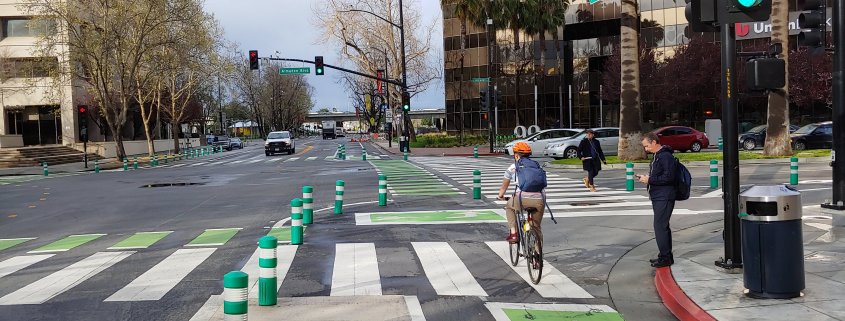6 Reasons Why We Love Quick-Build Projects
At CalBike, we have long been fans of quick-build projects. Early in the pandemic, we realized that quick-build projects are more crucial than ever. The pandemic temporarily reduced traffic, creating a demonstration of the way people-centered streets can look and feel. This created an opportunity for change. But we have to move fast.
The urgency of the situation spurred CalBike to action. We secured grants from the SEED Fund and the SRAM Cycling Foundation and collaborated with Alta Planning + Design to create a Quick-Build Guide that planners can use to develop quick-build projects.
If you feel resistant to quick-build, we’d like to change your mind — quickly.
What is quick-build design?
Quick-build is a method for reconfiguring streets without costly changes to the existing hardscape. Planners make intersection improvements and buffered bikeways using low-cost materials like paint, moveable planters, and bollards. The pre-implementation planning process is shorter. But, unlike traditional infrastructure projects, planning doesn’t stop once the design is on the ground. Because the elements of quick-build projects can be moved or altered without much effort or expense, the designs can easily evolve in response to community input.
Here are just six of the many reasons we love quick-build design.
Quick-build helps communities respond to the climate crisis with appropriate speed
In 2018, the IPCC warned that we have just 12 years to turn around our carbon consumption or face a planetwide catastrophe. To meet that deadline, we have to take bold action now, not in 2030.
Unfortunately, the planning process for a new bike lane or enhanced intersection in California can take years or even decades. A county-sponsored project to redesign a central transportation corridor in the East Bay for more active transit chose two initial projects to build quickly. The quick timeline: five years. The rest of the project will probably take ten years or more. With quick-build, these projects can be on the ground in five months at a fraction of the budget.
The climate crisis is already here. California has suffered through droughts and fires with increasing frequency as the Earth has warmed by 1℃. We can’t afford to double that
It’s more equitable to vet a design on the ground than on paper
With quick-build, we aren’t asking the public to spend their precious time studying drawings and imagining what their street could be like. Instead, we change the streets temporarily in real-time, so community members can get a feel for how the new designs work on the ground.
People with lots of time still get to see what it will look like and can still give input. Quick-build leads to more accessible and equitable outreach. Because commenters aren’t limited to people who are used to and comfortable with the “normal” outreach process, people who don’t usually get to weigh in on bike infrastructure have a voice.
Lower costs allow communities to build more for less
California cities don’t need one shiny, new bike project or a few protected intersections. We need safe, connected networks that allow riders of all ages to choose active transportation. Communities can put quick-build projects on the ground for a fraction of the price of traditional infrastructure. Not only are the materials less expensive, but communities can also save on staff time because the planning process is shorter and more practical. If we are to have any hope of making the transportation shift we need in time to mitigate climate change, quick-build is our best and perhaps our only hope.
Quick-build overcomes NIMBY resistance
If you’ve ever been to a public meeting about a bike project, you’ve probably heard statements like these:
“Why build a bike lane when so few people ride bikes here?”
“We need those parking spaces.”
“What about elderly people or parents with kids? They NEED to drive.”
Proposals to add infrastructure that will make biking safer strike terror in the hearts of motorists. They have visions of a helmeted mob dragging them out of their car and forcing them into the fresh air (or something equally horrific).
Quick-build bypasses the irrational fear stage of the public planning process. Car owners find that they can still drive, often more easily than before. People ride bikes and walk more, eliminating the “no one will use it” argument. Then streets become safer for kids to use, and the argument is won.
It’s easy to change flexible designs in response to changing conditions
When you pour concrete, you’re stuck with the street design, at least for a few years. But quick-build lends itself to iteration. Many quick-build features end up becoming permanent, but they can easily be altered in response to community feedback or changing community needs.
Quick-build projects save lives
With quick-build, there’s no excuse not to build protected bike lanes. Quick-build makes it cheap and easy to safe bike facilities that are protected from traffic. Buffers can be made from bollards, planters, or rubber car stoppers.
Separated bikeways benefit everyone. A recent study found that streets with protected bike lanes saw fewer traffic fatalities for all users – bike riders, pedestrians, and car drivers.
CalBike is working on getting our Quick-Build Guide into the hands of every California planner, administrator, and elected official who has input on street design. Your donation will help us make safe biking an option for more Californians. Do you want your planners to see the guide? Let us send them the executive summary. Give us the contact info and we’ll do the rest.





